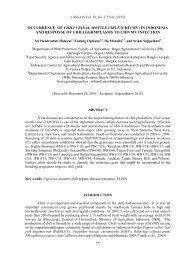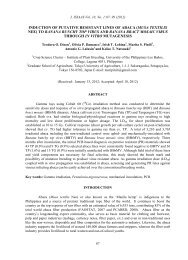Haploid plant production through anther culture in day-neutral
Haploid plant production through anther culture in day-neutral
Haploid plant production through anther culture in day-neutral
Create successful ePaper yourself
Turn your PDF publications into a flip-book with our unique Google optimized e-Paper software.
<strong>Haploid</strong> <strong>plant</strong> <strong>production</strong> <strong>through</strong> <strong>anther</strong> <strong>culture</strong> <strong>in</strong> <strong>day</strong>-<strong>neutral</strong> strawberry…..0.3 cm 0.5 cm 1 cma b c0.5 cm 1.5 cm 1 cmd e fg2.5 cmFig. 4. Plant regeneration by different callus ages <strong>in</strong> <strong>day</strong>-<strong>neutral</strong> strawberry cv. ‘Albion’a.1-month-old callus: small volume, soft; b. 2-month-old callus: compact, green-yellow; c: 3-montholdcallus: compact, yellow, large volume; d: 1-month-old callus after 2 months sub<strong>culture</strong>, brown;e: 2-month-old callus after 2 months sub<strong>culture</strong>, shoot formation; f: 3-month-old callus after 2 monthssub<strong>culture</strong>, root formation; g: <strong>plant</strong>let on B5 medium without hormone 2 months after sub<strong>culture</strong>.Arrow <strong>in</strong>dicated root formationJiajun and Kai-hua (2008) <strong>in</strong>dicated that the physiological condition and developmental stageof ex<strong>plant</strong>s played an important role <strong>in</strong> regeneration. Naveed et al. (2009) reported that the highest<strong>plant</strong> regeneration frequency <strong>in</strong> wheat embryogenic-callus <strong>culture</strong> (95% by cv. ‘Chakwal -97’) wasobta<strong>in</strong>ed from 26 <strong>day</strong>s old callus, whereas 48 <strong>day</strong>s old calli showed the lowest (13%). Decreas<strong>in</strong>g ofregeneration capability with <strong>in</strong>creas<strong>in</strong>g age of callus is a critical problem for callus ma<strong>in</strong>tenance andregeneration <strong>in</strong> Miscanthus x giganteus <strong>plant</strong> regeneration (Kim et al., 2010) and this f<strong>in</strong>d<strong>in</strong>g wassimilar to our results. On the other hand, S<strong>in</strong>gh et al. (2011) reported that the reduction of peroxidaseactivity can be highly correlated with <strong>in</strong>creas<strong>in</strong>g callus age and affected <strong>plant</strong> regeneration rate <strong>in</strong>Narigi crenulata (Roxb) <strong>culture</strong>. In strawberry, the <strong>plant</strong> regenerated from 8-week-old callus did notshow any dist<strong>in</strong>ct morphological variants while a significant proportion of deformed leaf shape (6 -13%) and yellow leaf (21 – 29%) was obta<strong>in</strong>ed among <strong>plant</strong>s regenerated from 16 and 24-week-oldcalli (Nehra et al., 1992). In our own results, the 3-month-old callus was degenerated and formedroots (Fig. 3F) such as Niemirowicz-Szcytt (1990) reported.Ploidy and cytological evaluation.When evaluat<strong>in</strong>g cytology, the regenerants derived from <strong>anther</strong> <strong>culture</strong> had different ploidylevels: haploid, hexaploid, octoploid, and doubled-octoploid. The number of chromosomes <strong>in</strong> haploidwas 28.3 chromosomes/cell, 41.6 for hexaploid, 55.8 for octoploid, 110.6 for doubled-octoploid, and52.9 for aneuploid (Table 4 and F ig 5a; 5b; 5c). Variation <strong>in</strong> ploidy was confirmed by count<strong>in</strong>gnumber of chloroplast <strong>in</strong> a stomata guard cell. Number of chloroplast per guard cell was 11.8, 17.4,20.9, 34.9, and 19.1 obta<strong>in</strong>ed from haploid, hexaploid, octoploid, doubled-octoploid, and aneuploidregenerants, respectively (Table 4 and Fig 5d; 5e; 5f). The ploidy ratio of regenerants via <strong>anther</strong><strong>culture</strong> of <strong>day</strong>-<strong>neutral</strong> strawberry was 6.1% haploid (tetraploid), 3% hexaploid, 69.7 % octoploid,6.1% doubled-octoploid, and 15.2% aneuploid (Table 4).180





